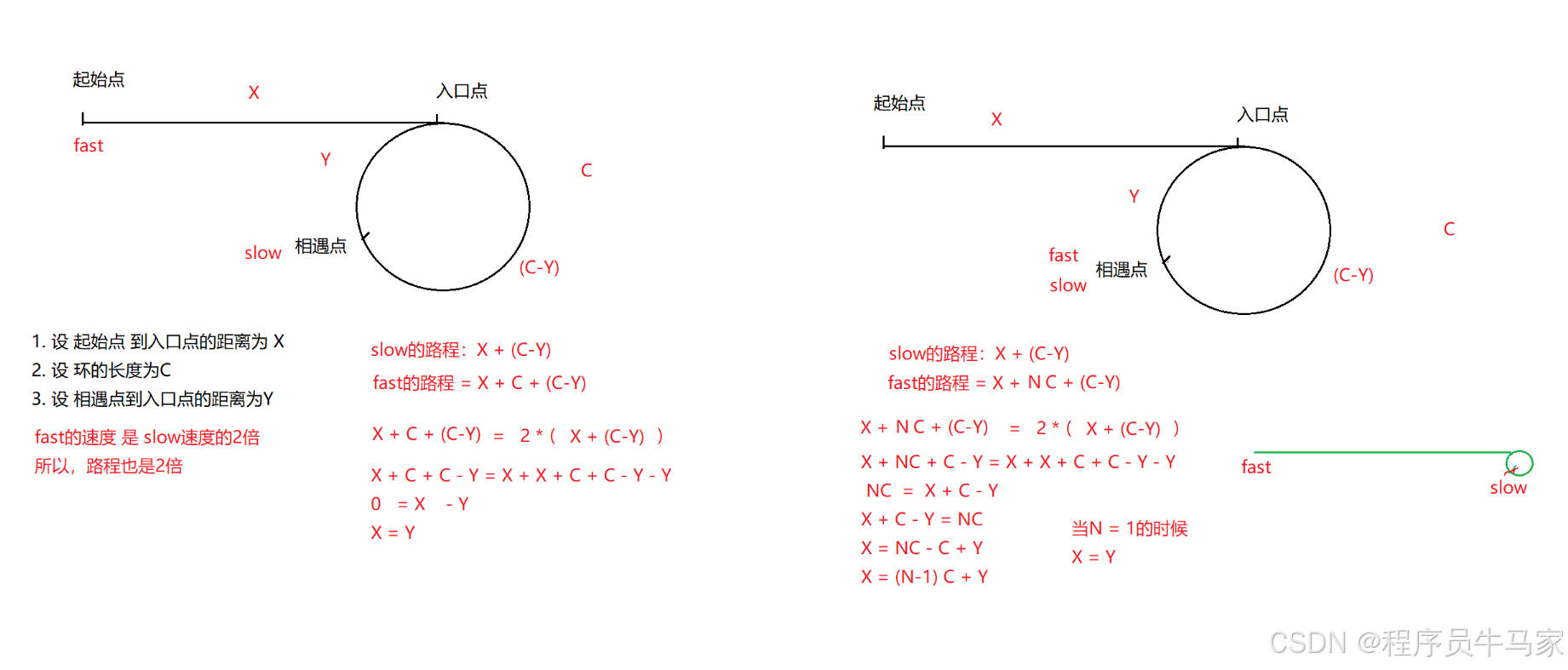1. 删除链表中等于给定值 val 的所有节点。 OJ链接

public ListNode removeElements(ListNode head, int val) {if (head==null) {return null;}ListNode cur=head.next;ListNode pre=head;while(cur!=null) {if(cur.val==val) {pre.next=cur.next;cur=cur.next;}else {pre=cur;cur=cur.next;}}if(head.val==val)head=head.next;return head;}
}

2. 反转一个单链表。 OJ链接

class Solution {public ListNode reverseList(ListNode head) {if (head == null) {return null;}ListNode cur = head.next;head.next = null;while (cur != null) {ListNode C = cur.next;cur.next = head;head = cur;cur = pre;}return head;}}3. 给定一个带有头结点 head 的非空单链表,返回链表的中间结点。如果有两个中间结点,则返回第二个中间结
点。OJ链接

class Solution {public ListNode middleNode(ListNode head) {ListNode fast=head;ListNode slow=head;while(slow!=null&&slow.next!=null) {fast=fast.next;slow=slow.next.next;}return fast;}
}
4. 输入一个链表,输出该链表中倒数第k个结点。 OJ链接

方法1
public int kthToLast2( int k) {if(k <= 0 ) {return -1;}ListNode fast = head;ListNode slow = head;int count = 0;while (count != k-1) {fast = fast.next;if(fast == null) {return -1;}count++;}while (fast.next != null) {fast = fast.next;slow = slow.next;}return slow.val;}
方法2
class Solution {public int kthToLast(ListNode head, int k) {ListNode cur=head;while(k!=0) {if (cur==null) {return -1;}cur=cur.next;k--;}if (k==0) {while(cur!=null) {cur=cur.next;head=head.next;}return head.val;}return -1;}
}
5. 将两个有序链表合并为一个新的有序链表并返回。新链表是通过拼接给定的两个链表的所有节点组成的。OJ

class Solution {public ListNode mergeTwoLists(ListNode list1, ListNode list2) {if(list1==null) {return list2;}if (list2==null) {return list1;}ListNode temp;if(list1.val>list2.val) {temp=list2;list2=list2.next;}else {temp=list1;list1=list1.next;}ListNode head=temp;while(list1!=null&&list2!=null) {if(list1.val>list2.val) {temp.next=list2;list2=list2.next;temp=temp.next;}else {temp.next=list1;list1=list1.next;temp=temp.next;}}if(list1!=null) {temp.next=list1;}if(list2!=null) {temp.next=list2;}return head;} }
6. 编写代码,以给定值x为基准将链表分割成两部分,所有小于x的结点排在大于或等于x的结点之前 。OJ链接

public class Partition {public ListNode partition(ListNode pHead, int x) {ListNode cur = pHead;ListNode be = null;ListNode bs = null;ListNode as = null;ListNode ae = null;while (cur != null) {if (cur.val < x) {if (bs == null) {bs = be = cur;} else {be.next = cur;be=be.next;}} else {if (as == null) {as = ae = cur;} else {ae.next = cur;ae=ae.next;}}cur=cur.next;}if(be==null) {return as;}if(ae!=null) {ae.next=null;}be.next = as;return bs;}
}
7. 链表的回文结构。OJ链接

public class PalindromeList {public boolean chkPalindrome(ListNode head) {ListNode fast=head;ListNode slow=head;while(fast!=null&&fast.next!=null) {slow=slow.next;fast=fast.next.next;}ListNode cur=slow.next;ListNode curN=cur;while(curN!=null) {curN=curN.next;cur.next=slow;slow=cur;cur=curN;}while(slow!=head) {if(head.val!=slow.val) {return false;}if (head.next==slow) {return true;}head=head.next;slow=slow.next;}return true;}
}
8. 输入两个链表,找出它们的第一个公共结点。OJ链接

public class Solution {public ListNode getIntersectionNode(ListNode headA, ListNode headB) {ListNode pl=headA;ListNode ps=headB;int len1=size(pl);int len2=size(ps);int leng=Math.abs(len1-len2);if(len1>len2) {while(leng!=0) {pl=pl.next;leng--;}}else {while (leng !=0) {ps=ps.next;leng--;}}while(ps!=null&&pl!=null) {if(ps==pl) {return ps;}ps=ps.next;pl=pl.next;}return null;}public int size(ListNode head) {int count=0;while (head!=null) {head=head.next;count++;}return count;}
}
9. 给定一个链表,判断链表中是否有环。 OJ链接

public class Solution {public boolean hasCycle(ListNode head) {if(head==null) {return false;}ListNode fast=head;ListNode slow=head;while(fast!=null&&fast.next!=null) {fast=fast.next.next;slow=slow.next;if(fast==slow) {return true;} } return false;}
}
【思路】
快慢指针,即慢指针一次走一步,快指针一次走两步,两个指针从链表起始位置开始运行,如果链表
带环则一定会在环中相遇,否则快指针率先走到链表的末尾。比如:陪女朋友到操作跑步减肥。
【扩展问题】
为什么快指针每次走两步,慢指针走一步可以?
假设链表带环,两个指针最后都会进入环,快指针先进环,慢指针后进环。当慢指针刚进环时,可能就和快
指针相遇了,最差情况下两个指针之间的距离刚好就是环的长度。此时,两个指针每移动一次,之间的距离
就缩小一步,不会出现每次刚好是套圈的情况,因此:在慢指针走到一圈之前,快指针肯定是可以追上慢指
针的,即相遇。
快指针一次走3步,走4步,…n步行吗?

按上面的方法,每次快指针走三步,慢指针走一步,永远不会相遇,因为快指针把慢指针套圈了。
因此只有快指针走2步,慢指针走一步,即使慢指针被套圈,slow和fast也是同一位置。
10. 给定一个链表,返回链表开始入环的第一个节点。 如果链表无环,则返回 NULL OJ链接

public class Solution {public ListNode detectCycle(ListNode head) {if(head==null) {return null;}ListNode fast=head;ListNode slow=head;while (fast!=null&&fast.next!=null) {fast=fast.next.next;slow=slow.next;if(slow==fast) {break;}}if(fast==null||fast.next==null) {return null;}fast=head;while (fast!=slow) {fast=fast.next;slow=slow.next;}return fast;}
}

